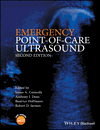Ultrasonography of Deep Venous Thrombosis
Summary
Venous thromboembolism (VTE) ranges in spectrum from small deep-vein thromboses (DVT) to life-threatening pulmonary emboli (PE). Venous ultrasonography of the lower extremity should be performed on any patient with a clinical suspicion of DVT. Venous ultrasonography is also of value in atypical chest pain, cardiac arrest and undifferentiated shock when it may reveal the source of the patient's symptoms, though the absence of DVT does not exclude venous thromboembolus. Traditional comprehensive studies include many elements to assess for DVT, including Doppler evaluation for abnormalities in venous blood flow. The two-point compression test, however, only uses B-mode grey-scale compressibility of the veins. Controversy regarding the clinical course and treatment of distal DVTs persists. For patients with a moderate or high pre-test probability of disease, a negative limited compressible ultrasound is traditionally followed by a repeat ultrasound in one week or by follow-up full-leg ultrasound, due to the concern that a missed distal DVT may propagate.



